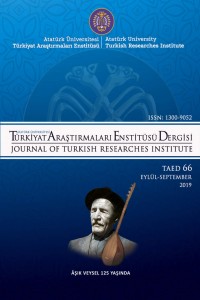Abstract
Stories, meaning of the word conveying, narration, imitating, reporting, have been incorporated into the folk narratives society in order to educate people religiously and morally with the adoption of Islam, in the old Turkish societies. With the development of the palace life, the importance of Iranian literature over time and the poets gathered around the palace to write works under this influence, the old story understanding changed and started to separate from the folk stories. The story concept in classical literature has been started to use for all narrated texts. The first period of classical Turkish literature products were mostly translation or adaptation from Arabic and Persian, rewriting of the works written within the framework of Islamic tradition without going beyond the main framework such as subject, names, main story, works written with the tradition of nazire were sought after the dimension of the boundaries drawn by tradition for poets. The works written on the same subject as a requirement of the same approach have been re-examined in different forms in different centuries. While some of the first story texts were written in verse, they were written in prose in later centuries, some prose stories were taken to the verse in the later centuries. The aim of this study is to reveal the process of transition from mesnevi to prose story. Mihr ü Vefâ, one of the couple's heroic stories, was one of the stories transformed into prose while the first one was a poetic. In the study, firstly the story and information about the story in Classical literature were given, then there is mention about the Mihr ü Vefâ mesnevi’s, finally, the poetic Mihr ü Vefa that belongs to Hâşimî and prose story Mihr ü Vefa belongs to unknown author comparison were made. Both mentioned copies were compared by divided into episodes, differences were revealed and their motives were evaluated.
Keywords
References
- Akün, Ömer Faruk. (1994). “Divan Edebiyatı”, Diyanet İslam Ansiklopedisi, C. 9 İstanbul: TDV Yay, 389-427. Alptekin, Ali Berat. (2016). Halk Hikâyelerinin Motif Yapısı. Ankara: Akçağ Yayınları. Çapanoğlu, Gökçenur. (2014). “Ümmî Îsâ Mihr ü Vefâ (Dil İncelemesi- Metin- Gramatikal Dizin)”. (Yayımlanmamış Yüksek Lisans Tezi). Erzurum: Atatürk Üniversitesi/ Sosyal Bilimler Enstitüsü. Dalkesen, Nilgün (2015). “Orta Asya’dan Anadolu’ya Türk Kültüründe Geyik Kültürü”, Millî Folklor, 106, 59-67. Ece, Selami. (1996). “Tahkiye Açısından Hâşimî’nin Mihr ü Vefa Mesnevisi –Transkripsiyonlu Metin-İnceleme” (Yayımlanmamış Yüksek Lisans Tezi). Erzurum: Atatürk Üniversitesi, Sosyal Bilimler Enstitüsü. Gürbüz, Mehmet ve Tuba Durmuş. (2017). “Nazımdan Nesre Anlatımın Dönüşümü: Dâsitân-ı Ferruh u Hümâ Örneği”. Divan Edebiyatı Araştırmaları Dergisi, 17: 147-168. Jung, Carl Gustav. (2005). Dört Arketip. İstanbul: Metis Yayınları. Karagözlü, Volkan. (2011). “Türk Edebiyatında Mihr ü Vefâ Mesnevileri ve Yazarı Bilinmeyen Bir Mihr ü Vefâ Mesnevisi -inceleme-metin” (Yayımlanmamış Yüksek Lisans Tezi). Nevşehir: Nevşehir Üniversitesi, Sosyal Bilimler Enstitüsü. Kavruk, Hasan. (1998). Eski Türk Edebiyatında Mensûr Hikâyeler (Araştırma-İnceleme Dizisi), Ankara: MEB Yayınları. Kavruk, Hasan ve İskender Pala.(1994). “Hikâye”, Diyanet İslam Ansiklopedisi, İstanbul: TDV yay. C. 17: 491-493. Ocak, Ahmet Yaşar. (1999). İslâm-Türk İnançlarında Hızır Yahut Hızır-İlyas Kültü. Ankara: Türk Kültürü Araştırma Enstitüsü. Ögel, Bahaeddin. (2010). Türk Mitolojisi I.II. Ankara: Türk Tarih Kurumu Yayınları.
Abstract
Kelime anlamı olarak nakletme, anlatma, taklit etme, haber verme anlamına gelen hikâye, İslamiyet’in kabulüyle eski Türk toplumlarında insanları dini-ahlaki yönden eğitmek amacıyla halk hikâyesi bünyesine girmiştir. Saray hayatının gelişmesi, İran edebiyatının zamanla önem kazanması ve saray çevresinde toplanan şairlerin bu etki altında eserler kaleme almasıyla birlikte eski hikâye anlayışı değişerek, halk hikâyelerinden ayrılmaya başlamıştır. Klasik edebiyattaki hikâye kavramı tahkiyeli bütün metinler için kullanılmaya başlanmıştır. İlk dönem klasik Türk edebiyatı ürünlerinin daha çok Arapça ve Farsçadan tercüme veya adaptasyon olması, İslam geleneği çerçevesinde yazılan eserlerin konu, isimler, ana hikâye gibi ana çerçevesinin dışına çıkılmadan yeniden kaleme alınması, nazire geleneğiyle yazılmış eserlerin rağbet görmesi, geleneğin şairlere çizdiği sınırların üretime yansıyan boyutudur. Aynı yaklaşımın bir gereği olarak aynı konuda yazılan eserler, farklı yüzyıllarda farklı formlarda yeniden ele alınmıştır. Kaleme alınan hikâye metinlerinin bir kısmının ilk halleri manzum iken daha sonraki yüzyıllarda mensur olarak yazılmış; bazı mensur hikâyeler ise daha sonraki yüzyıllarda nazma çekilmiştir. Bu çalışmanın amacı mesneviden mensur hikâyeye geçiş sürecini gözler önüne sermektir. Çift kahramanlı aşk hikâyelerinden olan Mihr ü Vefâ da ilk hâli manzum iken mensura dönüşmüş hikâyelerdendir. Çalışmada öncelikle hikâye ve Klasik edebiyatta hikâye hakkında bilgi verilmiş, daha sonra Mihr ü Vefâ mesnevilerinden söz edilmiş, son olarak da çalışmaya konu olan Hâşimî’ye ait manzum Mihr ü Vefâ ile yazarı bilinmeyen mensur bir Mihr ü Vefâ hikâyesinin mukayesesi yapılmıştır. Bahsi geçen her iki anlatı da epizotlarına ayrılarak karşılaştırılmış, farklılıklar ortaya konularak, motifleri değerlendirilmiştir.
Keywords
References
- Akün, Ömer Faruk. (1994). “Divan Edebiyatı”, Diyanet İslam Ansiklopedisi, C. 9 İstanbul: TDV Yay, 389-427. Alptekin, Ali Berat. (2016). Halk Hikâyelerinin Motif Yapısı. Ankara: Akçağ Yayınları. Çapanoğlu, Gökçenur. (2014). “Ümmî Îsâ Mihr ü Vefâ (Dil İncelemesi- Metin- Gramatikal Dizin)”. (Yayımlanmamış Yüksek Lisans Tezi). Erzurum: Atatürk Üniversitesi/ Sosyal Bilimler Enstitüsü. Dalkesen, Nilgün (2015). “Orta Asya’dan Anadolu’ya Türk Kültüründe Geyik Kültürü”, Millî Folklor, 106, 59-67. Ece, Selami. (1996). “Tahkiye Açısından Hâşimî’nin Mihr ü Vefa Mesnevisi –Transkripsiyonlu Metin-İnceleme” (Yayımlanmamış Yüksek Lisans Tezi). Erzurum: Atatürk Üniversitesi, Sosyal Bilimler Enstitüsü. Gürbüz, Mehmet ve Tuba Durmuş. (2017). “Nazımdan Nesre Anlatımın Dönüşümü: Dâsitân-ı Ferruh u Hümâ Örneği”. Divan Edebiyatı Araştırmaları Dergisi, 17: 147-168. Jung, Carl Gustav. (2005). Dört Arketip. İstanbul: Metis Yayınları. Karagözlü, Volkan. (2011). “Türk Edebiyatında Mihr ü Vefâ Mesnevileri ve Yazarı Bilinmeyen Bir Mihr ü Vefâ Mesnevisi -inceleme-metin” (Yayımlanmamış Yüksek Lisans Tezi). Nevşehir: Nevşehir Üniversitesi, Sosyal Bilimler Enstitüsü. Kavruk, Hasan. (1998). Eski Türk Edebiyatında Mensûr Hikâyeler (Araştırma-İnceleme Dizisi), Ankara: MEB Yayınları. Kavruk, Hasan ve İskender Pala.(1994). “Hikâye”, Diyanet İslam Ansiklopedisi, İstanbul: TDV yay. C. 17: 491-493. Ocak, Ahmet Yaşar. (1999). İslâm-Türk İnançlarında Hızır Yahut Hızır-İlyas Kültü. Ankara: Türk Kültürü Araştırma Enstitüsü. Ögel, Bahaeddin. (2010). Türk Mitolojisi I.II. Ankara: Türk Tarih Kurumu Yayınları.
Details
| Primary Language | Turkish |
|---|---|
| Subjects | Creative Arts and Writing |
| Journal Section | Makaleler |
| Authors | |
| Publication Date | September 15, 2019 |
| Published in Issue | Year 2019 Issue: 66 |


